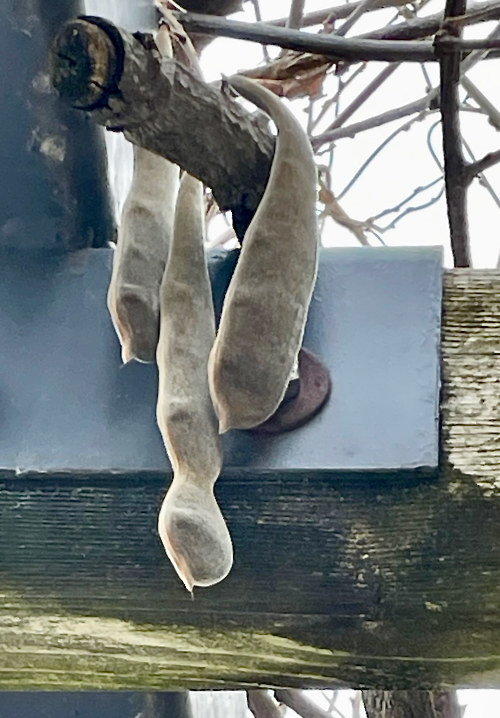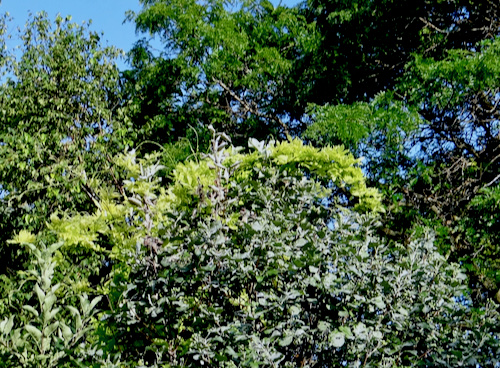
Plant of the Month March 2024
GENERAL INFORMATION:
Chinese Wisteria was introduced to the West in 1816. This seems odd as I picture it adorning the sides of Elizabethan half-timbered cottages. (Look for anachronisms in movies!) It produces long runners, up to 4-5m long, snaking along the soil surface,. These root and can produce a thicket. This plant is invasive, but beautiful. Our plant is about 40 years old; it came from an RBG sale. It has a RHS Award of Garden Merit.

Wisteria sinensis 'Prolific' mid May.
Synonym: Wisteria sinensis ‘Boskoop’, Wisteria sinensis 'Oosthoek's Variety'.
Common Name: Chinese Wisteria ‘Prolific’, Chinese Kidney Bean ‘Prolific’.
Life Cycle: Long lived vigorous, deciduous, perennial woody vine, twining counter-clockwise. Japanese Wisteria twines clockwise.
Special Needs: The vine can become very heavy and will need a strong support from first planting. It dislikes being moved - impossible in many cases.
Pruning: Wisteria needs frequent pruning. This easiest if done twice a year. The flowers are produced on the lower part of the previous year’s wood. The aim is to promote short, flowering spurs. Cut out any dead or dying wood when you see it and remove runners when they appear.
Prune any long shoots to about 15 cm in early July, keeping any that are needed to increase the framework.

Wisteria pruned.
For a small tree form or a potted plant, repeat this whenever you see whips growing.
Cut back the previous year’s growth to 2 or 3 buds in mid March, when above freezing.
Height: Up to 20 m.
Bloom Time: Mid to late May, as leaves unfold. "Prolific' blooms again, sporadically through the summer. Japanese Wisteria blooms just after the leaves have unfolded.

Wisteria sinensis 'Prolific' late May.
Flower Colour & Size: Lilac-blue scented flowers, 2 - 2.5 cm in size, typical pea shaped, in dense down-hanging racemes, up to 25 cm long.

Wisteria sinensis 'Prolific' showing racemes and leaves.
Leaves: Compound pinnate leaves with up to 13 mid to dark green leaflets.
Fruit: Large, hairy, brown bean-like seed pods, up to 15 cm long. Seeds flattish, 2 cm across. Opening in early winter.

Wisteria sinensis -'Beans'. Image J. Dixon.
Range: Native to western China.
Habitat: Cliffs and woods.
CULTIVATION:
Plant: on a pergola or trellis above a deck, against the side off a house, up a strong tree, or train as a free-standing small tree,
Light: Full sun to partial shade. Somewhat drought tolerant.
Soil: Any soils, moist and well drained.
Water: Average needs.
USDA Hardiness: Zones 5 - 8.
Fertilization: Nitrogen fixing, so plants in the ground will not need any fertilizers. Plants in pots should be given high Phosphorus food in the spring.
Problems, Pests and Diseases: Poisonous. Wisteria vines can become very heavy and might break or smother support. Usually problem free. Very wet soils may cause root rot. As well, crown gall and canker can occur. The wisteria borer larvae may attack the stems.

Wisteria sinensis smothering Sorbus.
Propagation: By seed: Sow @ 20°C. Seed germinates within 3 months First: requires scarification. Nick or rub between sheets of sandpaper. Soak in warm water until seeds swell, usually 24-48 hours. Discard water and any seeds that remain floating.
Soft or hardwood cuttings.
Layering: The long runners will frequently root along their length. Sections can be cut off and carefully potted. Better, bend the stem and place in a pot of soil, carefully weighted down. Remove from parent when a new shoot appears. Beware of any runners from below a graft.
Companion planting: Early roses - soft yellows and pinks.
Near Native Alternatives: Kentucky wisteria (W. macrostachya) Zone 5-9, grows to only about 6 m. American wisteria (W. frutescens) is taller, with much shorter racemes. Both are native to SE USA.
Pollinators: Eastern Carpenter bees, bumblebees.
References:
https://www.missouribotanicalgarden.org/PlantFinder/PlantFinderDetails.aspx?taxonid=265854
https://onrockgarden.com/index.php/germination-guide
https://www.gardenia.net/plant/wisteria-sinensis-prolific-chinese-wisteria
https://www.torontomastergardeners.ca/ask-list/
Text and images supplied by Anna Leggatt (Toronto Master Gardener)
